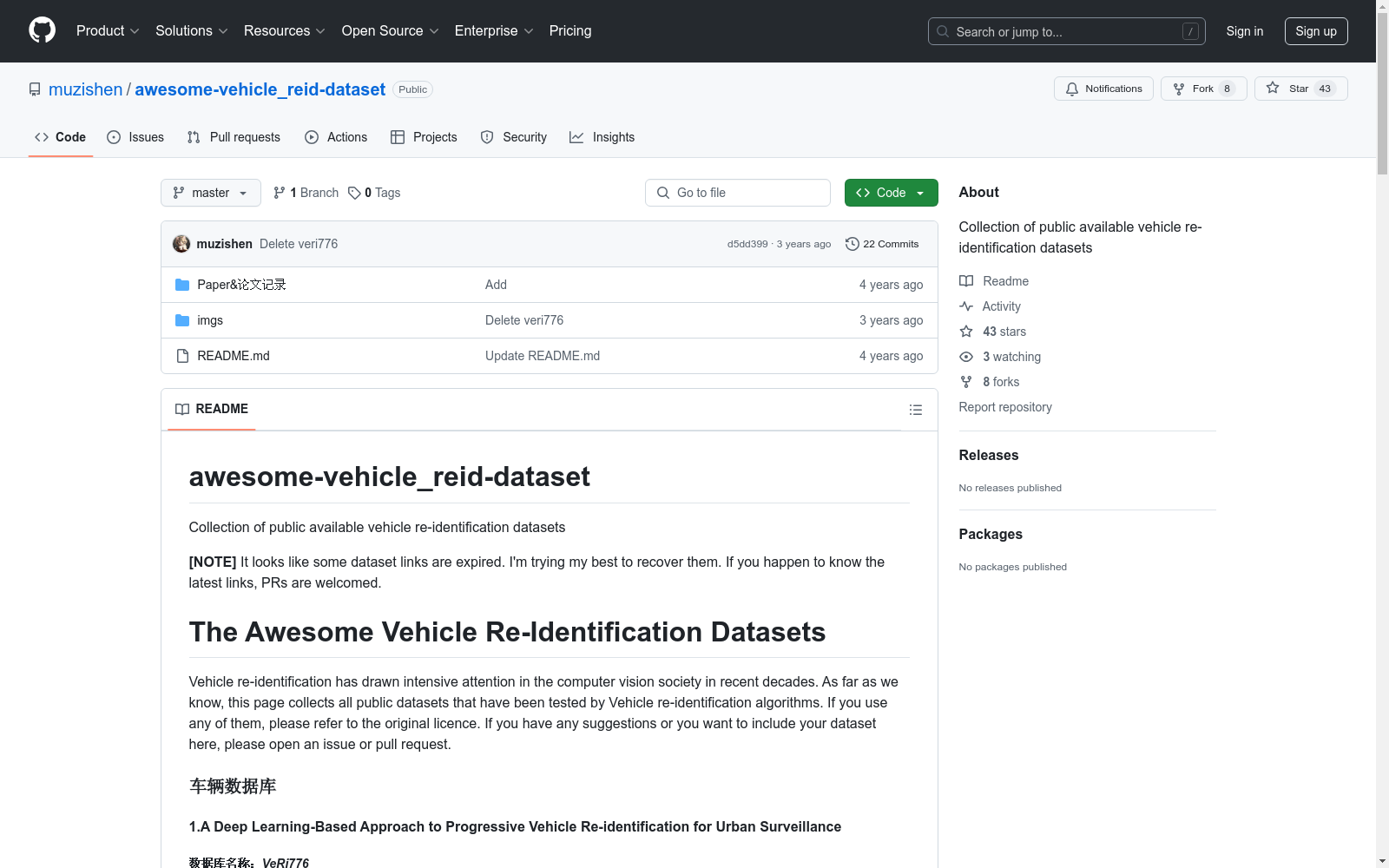VeRi776, VehicleID, VERI-Wild, VRAI, N-CARS, PKU-VD|车辆识别数据集|图像处理数据集
收藏数据集概述
1. VeRi776
- 数据库名称:VeRi776
- 数据库描述:包含超过50,000张776辆车的图像,由20台摄像机在24小时内拍摄,覆盖1.0平方公里。图像在真实世界的无约束监视场景中捕获,并标有不同的属性,如BBox、类型、颜色和品牌。
- 下载地址:链接
2. VehicleID
- 数据库名称:VehicleID
- 数据库描述:包含26267辆车(共221763张图像),图像在白天由多个真实监控摄像头在中国一个小城市中捕获。每个图像都带有一个与现实世界中的身份相对应的id标签。
- 下载地址:链接
3. VERI-Wild
- 数据库名称:VERI-Wild
- 数据库描述:包含40万张图片,4万种车辆标签,由174个摄像机在超过200平方公里的市区CCTV系统拍摄,考虑了车辆在各种天气和光照条件下的真实情况。
- 项目地址:链接
- 下载地址:链接 密码:kob9
4. VRAI
- 数据库名称:VRAI
- 数据库描述:包含137613张图像,13022种车辆类别,使用无人机上的摄像头进行拍摄,每辆车至少有两个无人机在不同位置、视角和飞行高度(15m至80m)进行拍摄。
- 提交者联系方式:bingliang.jiao@mail.nwpu.edu.cn
5. N-CARS
- 数据库名称:N-CARS
- 数据库描述:基于现实事件的数据集,由约24000个样本组成,从市区和高速公路环境中的汽车驾驶中获取,用安装在汽车挡风玻璃后面的ATIS摄像机拍摄。
- 下载地址:链接
6. PKU-VD
- 数据库名称:PKU-VD
- 数据库描述:包含两个大型车辆数据集(VD1和VD2),分别从两个城市的真实世界不受限制的场景拍摄图像。VD1从高分辨率交通摄像头获得,VD2从监视视频中获取。
- 数据库链接:链接
- 下载链接:填写协议,后下载
7. 百度阿波罗3D汽车数据集
- 数据库名称:百度阿波罗3D汽车数据集
- 数据库描述:数据集中包含相机固有参数、汽车模型集、汽车位置标记、汽车图像及训练和验证图像的索引。
- 下载地址:链接
8. Cars Dataset
9. CompCars
- 数据库名称:CompCars
- 数据库描述:包含来自网络和监视的两个途径的图像,网络图像包含163种车辆品牌,1,716种车型,共有136,726张整个汽车的图像,27,618张汽车零件图像。
- 项目连接:链接
- 下载链接:填写承诺书,然后发邮件,获取下载链接
10. BIT -Vehicle
- 数据库名称:BIT -Vehicle
- 数据库描述:包含9580个车辆图像和6种车型:轿车、运动型多用途车(SUV)、小型客车、卡车、公共汽车和小型货车。
- 下载地址:链接 密码:29cf
11. VehicleGrouping
- 数据库名称:VehicleGrouping
- 数据库描述:包含大约140万张图片,用于车辆的细粒度识别以及包括比例尺在内的摄像头校准。
- 项目网址:链接
12. BoxCars116k
- 数据库名称:BoxCars116k
- 数据库描述:由多个监控摄像头从各个角度拍摄116K车辆图像。
- 项目网址:链接

ANC
美国国家语料库(American National Corpus,简称ANC)是一个大规模的电子美国英语语料库,包含多种类型文本及口语数据转录,旨在全面反映美国英语的多样性。其开放部分OANC约有1500万字,涵盖多种文体,且进行了自动标注。
anc.org 收录
AIS数据集
该研究使用了多个公开的AIS数据集,这些数据集经过过滤、清理和统计分析。数据集涵盖了多种类型的船舶,并提供了关于船舶位置、速度和航向的关键信息。数据集包括来自19,185艘船舶的AIS消息,总计约6.4亿条记录。
github 收录
中国1km分辨率逐月平均气温数据集(1901-2024)
该数据为中国逐月平均温度数据,空间分辨率为0.0083333°(约1km),时间为1901.1-2024.12。数据格式为NETCDF,即.nc格式。数据单位为0.1 ℃。该数据集是根据CRU发布的全球0.5°气候数据集以及WorldClim发布的全球高分辨率气候数据集,通过Delta空间降尺度方案在中国降尺度生成的。并且,使用496个独立气象观测点数据进行验证,验证结果可信。本数据集包含的地理空间范围是全国主要陆地(包含港澳台地区),不含南海岛礁等区域。nc数据可使用ArcMAP软件打开制图; 并可用Matlab软件进行提取处理,Matlab发布了读入与存储nc文件的函数,读取函数为ncread,切换到nc文件存储文件夹,语句表达为:ncread (‘XXX.nc’,‘var’, [i j t],[leni lenj lent]),其中XXX.nc为文件名,为字符串需要’’;var是从XXX.nc中读取的变量名,为字符串需要’’;i、j、t分别为读取数据的起始行、列、时间,leni、lenj、lent i分别为在行、列、时间维度上读取的长度。这样,研究区内任何地区、任何时间段均可用此函数读取。Matlab的help里面有很多关于nc数据的命令,可查看。数据坐标系统建议使用WGS84。
国家青藏高原科学数据中心 收录
YOLO-dataset
该数据集用于训练YOLO模型,包括分类、检测和姿态识别模型。目前支持v8版本,未来计划支持更多版本。
github 收录
THCHS-30
“THCHS30是由清华大学语音与语言技术中心(CSLT)发布的开放式汉语语音数据库。原始录音是2002年在清华大学国家重点实验室的朱晓燕教授的指导下,由王东完成的。清华大学计算机科学系智能与系统,原名“TCMSD”,意思是“清华连续普通话语音数据库”,时隔13年出版,由王东博士发起,并得到了教授的支持。朱小燕。我们希望为语音识别领域的新研究人员提供一个玩具数据库。因此,该数据库对学术用户完全免费。整个软件包包含建立中文语音识别所需的全套语音和语言资源系统。”
OpenDataLab 收录
